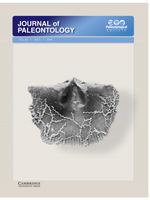Transmitted light and scanning electron imaging of sectioned specimens of Conularia and Paraconularia, prepared using HCl etching and critical point drying, revealed that their periderm is composed of extremely thin (approximately 0.5–3 μm), variably distinct microlamellae that are alternately organic poor and organic rich. Organic-rich microlamellae are cross-connected by slender strands of organic matter originally embedded in calcium phosphate, which in etched specimens has been dissolved. Microlamellae may be organized in thicker (approximately 5–75 μm) layers, or macrolamellae, that vary in color and organic matter content, possibly owing to changes in the ambient paleoenvironment. Thickening of the periderm to form transverse ribs and internal carinae was achieved through gradual thickening of individual microlamellae. In the core of the transverse ribs and internal carinae the distinction between organic-rich and organic-poor microlamellae may be reduced, owing to organic material becoming dominant over (former) mineral matter or vice versa. Combined with observations of plicated aperture closure in thin-walled conulariids, including Archaeoconularia slateri (Reed, 1933) (Upper Ordovician, Scotland) showing smooth folding of midline carinae through angles greater than 90°, these results suggest a structure and original flexibility in the organic-rich biocomposite forming the conulariid periderm that supports its homology to the chitinous lamellar periderm of coronate scyphozoans.
How to translate text using browser tools
1 May 2016
Microstructure and composition of the periderm of conulariids
Robert C. Ford,
Heyo Van Iten,
George R. Clark II
ACCESS THE FULL ARTICLE

Journal of Paleontology
Vol. 90 • No. 3
May 2016
Vol. 90 • No. 3
May 2016




